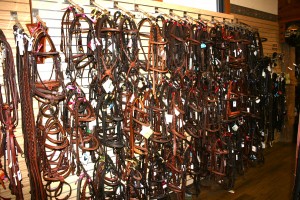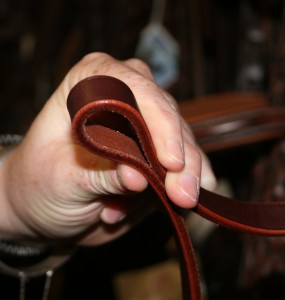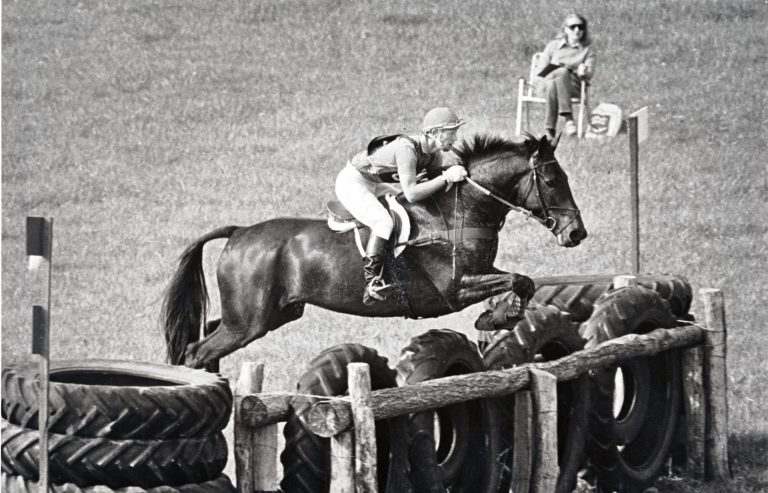Shopping for an English bridle is not the simple task it once was. Walking into Mary’s Tack & Feed in Del Mar, California, the customer is confronted with a 25-foot wall’s worth of English bridle choices, ranging in price from $50 to $500. And that’s just bridles suitable for hunter and jumper schooling and competition. The wall of dressage bridles around the corner is almost as long.
 Finding the right bridle for your horse boils down to fit, style, preference and budget.
Finding the right bridle for your horse boils down to fit, style, preference and budget.OK, so let’s narrow the search down by budget. Say, $200. At Mary’s, that still leaves you with at least 10 choices from six or seven manufacturers on the hunter/jumper wall. And that’s just the English bridles stocked by one tack store, albeit a large and reputable store whose stocking modus operandi is “good, better, best.” Catalogs and online retailers multiply your options, as do boutique bridle makers with small, typically handcrafted lines.
Choosing the right bridle boils down to fit, style, your own preferences and budget. If you have flexibility in your funds, keep in mind that the quality of leather and craftsmanship are keys to how long a bridle will last. Bridle care, however, is the biggest factor in the longevity of a bridle in any price range.
At many A-circuit hunter/jumper barns, trainers often have well-known bridle preferences. In these cases, shopping is a quick trip to the local tack store where staff sends the shopper home with her trainer’s favorite bridle. But for those of you who need to do the legwork yourself, here’s our Practical Horseman primer.
Fit & Flatter Your Horse
Choose a bridle style that fits and complements the size and shape of your horse’s head. Wider nosebands are a current trend in the hunter ring, but don’t be a blind bandwagoner. “Whether it’s in fashion or not, if it doesn’t look good on your horse, it’s not a good choice,” notes Mary’s senior store manager Juls Lorenz.
In general, bigger, strongly boned heads look best in substantial-looking bridles. This look is typically accomplished with relatively wide nose- and browbands and/or padding that adds depth and sometimes width to these pieces. For horses with smaller, more refined heads, the padding can add a nice dimension, but you probably want a thinner nose- and browband to minimize bulk.
Smith-Worthington’s Signature Clincher Bridle is an example of using a bridle element to balance a facial feature. It has clinchers (a row of silver or brass pieces) on the noseband instead of more traditional placement on the browband, a nice way to offset a heavy forelock.
“A good, clean fit is critical to showing off your horse’s head,” says Juls. One rule of thumb is having the buckles of the noseband hanger, cheekpiece and throatlatch near each other, but not overlapping. And avoid excess leather. “You want enough strap to go through the buckle and the keeper and to cover up any stitching, but you don’t want two or three inches of [excess] leather below the buckles.”
Precise fit can be a big challenge in a stock bridle. A full-size horse bridle may fit beautifully everywhere but the browband, where you might need a size from the bigger warmblood or oversize bridle or the smaller cob size. In general, the higher-end bridle makers sell separate and, in some cases, custom-made pieces, though you typically need to add that to the cost of the whole bridle.
Borrowing bridles from barnmates is a great way to figure out which manufacturers make the best fit for your horse. Taking your horse’s head dimensions is also smart. Using a flexible measuring tape, note the lengths for
- the circumference of his nose where the noseband sits,
- the width of the brow between the two points where the browband will connect with the headstall,
- the entire length of the headstall, starting at the bit on one side, up over the poll and down to the bit on the other side and
- the throatlatch length, starting behind one ear, down under the throat and up to a spot behind the other ear.
Expect that the bridle leather may stretch a little over time, and factor in how tightly you usually fasten the noseband and throatlatch.
The Comfort Craze
“We are definitely moving toward making the horse more comfortable so he can perform better,” says Jamie Greene, who owns the growing boutique bridlery, Five Star Tack. Mainstream bridle makers began incorporating comfort-driven design a few years ago, but many attribute the trend’s origins to the Micklem bridle.
An Innovation Award winner at the British Equestrian Trade Association show in 2008, the Micklem is designed to prevent pressure on facial nerves, the poll and the cheek and upper-jaw bones. Alleviating poll pressure is accomplished with a wider, padded and single-piece crown that does not have a separate cavesson strap running under it. Variations on that design dominate the poll-oriented comfort craze in today’s offerings from most manufacturers.
Horses who don’t like to be handled near their ears, poll or the top of their mane may benefit from these new designs. Headshaking and other signs of general discomfort while being ridden are indicators that the new styles are worth a try.
Most comfort-oriented bridles are done discreetly enough that judges are unlikely to notice, let alone penalize, them in the show ring. “I don’t think a (hunter or ?equitation) judge is going to pin you higher or lower because you use one of these designs,” Jamie says. “But the more popular ones are those that maintain a traditional bridle outline.”
The movement brings many new terms to the bridle lexicon. “Mono,” “single,” “integrated,” “recessed,” “padded,” “comfort” and “contoured” are prefixes for the crownpiece (headstall) in most of today’s bridles. In some cases, manufacturers use different terms for similarly constructed styles.
Here’s a rundown of terminology:
- Mono and single crown. The cavesson is attached directly to the headstall, rather than having its own strap that runs under a traditional headstall. These styles require a special cavesson with two short straps, which is critical if you need to replace it. Mary’s Tack & Feed now stocks such cavessons, but that may not be the case everywhere.
- Integrated & recessed crowns. An integrated crown can be the same as a mono or single crown, or it can indicate a headstall in which the cavesson strap goes over the headstall, sometimes in a recessed groove
- Comfort & contoured crown. ?”Comfort” usually means the headpiece is padded on the side that lays against the horse, and “contoured” usually refers to slight curves behind the ears. However, a “padded” bridle usually refers to appearance and/or comfort-driven padding on the nose- and browband, but these bridles can also include padding for comfort in the crownpiece.
Leather Quality
The types of bridle leather and the number of manufacturers has multiplied considerably since 20 or 30 years ago, when choices consisted primarily of English or American leather, and there were just a handful of bridle and strapgoods makers. Good quality leather, however, has become harder to find at reasonable prices. Decreasing demand for red meat is one of many factors that have reduced the cow population and the hides that come from it, resulting in higher prices for top-quality leather.
Good-quality leather starts from hides free of inconsistencies and blemishes. Some leathers are named for their place of origin: for example, Sedgwick curriers in England, English and American. Leathers are often sourced in one place and finished in another and labeled in ways that don’t correspond to either.
Jamie’s Five Star Tack line of bridles is made from Sedgwick leather, while her middle-price line, Symphony, is made of American leather from Wicket & Craig. Five Star hunter bridles run in the mid-$300s, Symphony in the mid-$200s. Jamie finds that companies who put their name on their leather can generally be counted on for consistent quality.
The tanning or finishing process is as or more important than the source of the leather. Vegetable-tanned leather is the best for bridles. In this process, the color of the leather permeates the entire fiber structure, Jamie explains. “If you bend back the leather, the color doesn’t change.” Leathers onto which the color has been painted will fail this test. Dyes applied in this less-expensive method are likely to bleed when wet from sweat or rain, and fade over time.
 The color of vegetable-tanned leather permeates the entire fiber instead of just being painted on.
The color of vegetable-tanned leather permeates the entire fiber instead of just being painted on.Because the quality of the leather is largely dictated by how much you can spend, Juls says the most important thing consumers need to know about leather is how to care for it. More on that later.
Craftsmanship
At first glance, and for those of us who don’t buy bridles often, it’s not always easy to tell the difference between a $50 and a $500 bridle. Here are some tips for determining the quality of workmanship that went into the bridle, which ?affects longevity.
- Study the stitching. Are the patterns centered on the brow- and nosebands? Look on the “wrong” side of the noseband. Is the stitching straight or uneven? Are the connection points stitched or bolted or stapled? The latter two techniques are faster and cheaper techniques, but usually not better. Is the stitching dense and tight? (One of the most popular high-end lines at Mary’s, Hadfields Bridleworks, features 12 stitches per inch.) And does the thread look thick and sturdy?
- Examine the nose- and browband. Higher-end bridle makers use leather inserts to create the raised effect popular in the hunter ring, and they are generally more flexible than plastic inserts often found in less expensive lines. A better-made bridle will use an almost undetectable vertical slit to insert these pieces. Lesser techniques often split the entire length of the band, making the whole piece more prone to breakage.
- Behold the buckles and holes. Look for buckles that seem sturdy, snug fitting and smooth functioning. Were the holes punched correctly, with the front hole smaller than its exit point on the strap’s wrong (rough) side? If so, the piece will be easier to attach and look tidier. If not, it’s a sign of shoddy workmanship.
- Evaluate the edges and grain. Better bridles have smooth edges from hand-beveling and finishing techniques. And the wrong side of the leather will be smoother, too, with a tighter grain.
Care Is Critical
How you care for your bridle is the biggest determinant in how long it will last and how good it will look throughout its life. The manufacturer is always right when it comes to the best methods for both break-in and regular care. These often include recommendations for daily care and specific conditioning products and treatments.
“It’s shocking for some people to learn that some bridles should not be oiled at all,” observes Juls. “Hadfields used to send their bridles out with a tag that said ?Oil’ inside that circle with a diagonal slash through it.”
“In a lot of the higher-end bridles, the leather is already finished with a good amount of waxes and tannins in them,” Juls continues. “Typically, those bridles just need time to soften and to break into the animal they are for.”
The once common practice of dipping and soaking a new bridle in oil can often be very destructive. “A higher quality bridle will undergo this process without any obvious signs of destruction, but down the road it won’t last as long,” Juls says. Over-oiling can break down the fibers in the leather and the stitching, especially in bridles in the lower price ranges. “These often have glue reinforcing the stitching, and oil breaks down glue.”
Caring for a bridle per the manufacturer’s recommendations often goes against tradition. “A trainer with the best intentions and years of experience can care for her bridles in a way she is happy with, but I don’t think she realizes what more she could be getting out of her bridles if she followed the manufacturer’s suggestions,” Juls observes.
Get Help
Knowledge is a great source of confidence in the bridle-buying process, but it’s not a substitute for working with a trustworthy tack supplier with a reasonable return policy. Arm yourself with good questions and an open mind and enjoy the journey into today’s extensive selection of bridles.
This article originally appeared in the June 2012 issue of Practical Horseman magazine.










